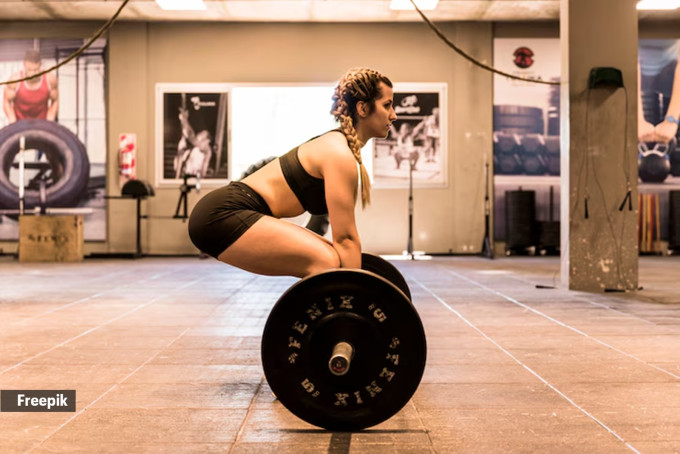Deadlift vs Romanian deadlift: Is one better than the other?
The conventional deadlift is popular among beginners and regular gym goers alike as an excellent exercise to build more muscle and strength.
Necessary for developing core strength, deadlifts aid the formation of more muscle mass and endurance and are usually performed with barbells. Even though the conventional form is a popular strength training exercise, there are several variations that one can choose from — with the Romanian deadlift being one of them.

Spoorthi S, a fitness expert at Cult describes it as another variation that makes use of a barbell. “Similar to its traditional counterpart, this exercise is a posterior chain powerhouse and offers many advantages,” she admits.
Key differences between traditional deadlift and Romanian deadlift
There are several differences between the two forms of exercises including the movement, form, range of motion as well as targeted muscles. Spoorthi S elaborates on these:
Traditional deadlift
Beginning position: The barbell is placed on the ground at the beginning of a traditional deadlift.
Movement pattern: Keeping the spine neutral, the movement entails raising the weight off the ground and into a standing position.
Range of motion: The barbell moves from the floor to the hip level, encompassing the entire range of motion.
Targeted muscles: The posterior chain muscles, which include the hamstrings, glutes, lower back, and traps, are the main targets of the traditional deadlift.
Technique: To lift the weight off the ground, a more intense movement is needed, using more fast-twitch muscle fibers.
Romanian deadlift
Starting position: In a Romanian deadlift, you start with the barbell at hip level, typically by lifting it from a rack or using blocks.
Movement pattern: The movement involves hinging at the hips while keeping the knees slightly bent, lowering the weight towards the ground, and then returning to the starting position.
Range of motion: It involves a partial range of motion, typically stopping at or slightly below knee level.
Muscles targeted: The Romanian deadlift primarily targets the posterior chain, with a greater emphasis on the hamstrings and lower back.
Technique: It requires a slower, more controlled movement compared to the traditional deadlift, focusing on the eccentric phase to stretch and strengthen the muscles.
Comparison in terms of strength, development and muscle hypertrophy
For strength development, Spoorthi S says, the traditional deadlift is excellent as it allows you to lift heavier loads due to the explosive nature of the movement. In case of the Romanian deadlift, while it may not allow for lifting heavy weights like the traditional deadlift, it is still considered effective for strength development, especially in the hamstrings and lower back.
Conventional deadlift stimulates muscle growth across multiple muscle groups, including the hamstrings, glutes, lower back, and traps, while the Romanian deadlift can lead to significant muscle hypertrophy in the hamstrings, as it places a greater emphasis on this muscle group during the movement.
 The Romanian deadlift primarily targets the posterior chain, with a greater emphasis on the hamstrings and lower back. (Source: Freepik)
The Romanian deadlift primarily targets the posterior chain, with a greater emphasis on the hamstrings and lower back. (Source: Freepik)
Specific scenarios or goals where one exercise might be more beneficial
For powerlifters or those focusing on maximal strength, the traditional deadlift is essential for building strength off the floor and improving overall performance in the deadlift, according to Spoorthi S. Additionally, athletes may benefit from the explosive nature of the traditional deadlift, as it mimics movements such as jumping and sprinting.
Individuals looking to specifically target and develop their hamstrings, she says, may find the Romanian deadlift more beneficial due to its emphasis on this muscle group. The controlled nature of the Romanian deadlift makes it suitable for individuals recovering from lower back injuries, as it minimises spinal loading while still providing a strengthening stimulus to the posterior chain.
Choosing the right variation based on fitness level, goals, and limitations
Spoorthi S stresses that it is essential to have a clear goal in mind when it comes to fitness and tailor a workout plan based on that. Based on the level of experience in weightlifting, she suggests individuals to progress gradually, integrating more demanding exercises with time.
For beginners, she says, the Romanian deadlift is considered to be more suited for beginners as it is a more controlled form of lifting weights. It will give you an idea of what kind of posture is best suited for you and how much weight your body can endure.
Intermediate and advanced lifters can include both variations in their training routine. “They can prioritise the traditional deadlift for overall strength development and then add Romanian deadlifts as an accessory exercise to target specific muscle groups or address weaknesses,” she proposes.
Individuals with hypertrophy goals may prioritise the Romanian deadlift to target specific muscle groups such as the hamstrings and glutes, while those focused on maximal strength may emphasise the traditional deadlift.
Those with lower back issues or limitations may find the Romanian deadlift more suitable due to its reduced spinal loading. However, proper form and technique are crucial for both variations to minimise the risk of injury, she adds.
Spoorthi S agrees that the Romanian deadlift is considered safer, as it allows for better control of the movement and focuses on controlled lifting rather than lifting maximum weight.
“It’s particularly effective for targeting the glutes and hamstrings, making it a preferred choice for muscle-building purposes. However, the standard deadlift is praised for simulating real-life movements and building overall strength, especially when lifting heavy weights from the ground up,” she says.
Ultimately, the choice between the two exercises depends on individual goals and preferences. Both variations can be incorporated into a training routine, with each offering unique benefits. Mixing these exercises in a weekly routine can help improve overall strength and muscle development.
Disclaimer: The copyright of this article belongs to the original author. Reposting this article is solely for the purpose of information dissemination and does not constitute any investment advice. If there is any infringement, please contact us immediately. We will make corrections or deletions as necessary. Thank you.





